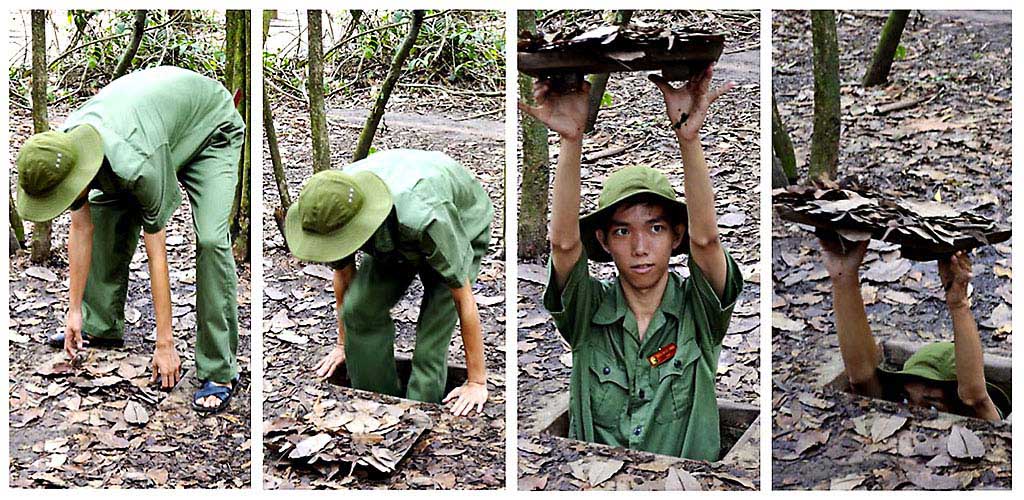Cu Chi Tunnels History & Tour
Are the tunnels of Cu Chi, Saigon's most popular tourist site, worth a visit? Definitely consider skipping if your stay in the Vietnam or Saigon may be limited, or have time to see the ones near Hue. Derided as kitschy and a symbol of "war tourism" replete with mannequins and a firing range, nonetheless the Cu Chi Tunnels are Saigon's, and indeed, Vietnam's most popular day-trip destination along with the nearby colorful Cao Dai Great Temple at Tay Ninh. Note that the massive underground complex is not what you will see (which no longer exists), but a short tunnel replica. Rather, consider the vibrant Mekong Delta witnessing the unique river life on the rivers, including floating markets and cycling village footpaths.
The Cu Chi Tunnels are situated near the village of Ben Suc, about 50 miles northwest of Saigon, and some 25 miles from the town of Cu Chi itself. The tunnels were part of a legendary underground network of small tunnels that zigzagged from the southern tip of the Ho Chi Minh Trail near the Cambodian border to the Saigon River. Most Vietcong tunnels in the Cu Chi area have been destroyed, sealed, or decayed by annual monsoons and flooding, but a few passageways were enlarged to accommodate Western tourist bodies.
During the war, the Vietcong would crawl on their bellies through the dark, dank tunnels, but visitors can walk through them (albeit hunched over). After scrambling through the tunnels for a claustrophobic, sweaty 15 minutes, you'll wonder how anybody could last a day in the tunnels, let alone a year. Below ground was a complete system of kitchens, rudimentary clinics and operating rooms, meeting rooms, and sleeping chambers with bamboo beds and an underground community developed, with people getting married and women gave birth down below. The network also incorporated storage chambers for weapons and rice, drinking wells, ventilation shafts, false tunnels, and booby-trapped passages.
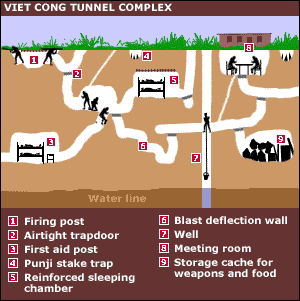 The Vietnamese spent decades digging in the reddish brown laterite clay in this area the tunnels were all built with simple hand tools. Up to 30 miles of tunnels were constructed by the Vietminh fighting the French between 1948 and 1954. Between 1960 and 1965, their successors, the Vietcong, added an astonishing three-level network four times as big, bringing the total up to over 120 miles. The deepest layer of tunnels lay 36 feet underground. Up to 16,000 guerrillas could live in the tunnel complex at any one time, though 5,000 to 7,000 was the normal complement.
The Vietnamese spent decades digging in the reddish brown laterite clay in this area the tunnels were all built with simple hand tools. Up to 30 miles of tunnels were constructed by the Vietminh fighting the French between 1948 and 1954. Between 1960 and 1965, their successors, the Vietcong, added an astonishing three-level network four times as big, bringing the total up to over 120 miles. The deepest layer of tunnels lay 36 feet underground. Up to 16,000 guerrillas could live in the tunnel complex at any one time, though 5,000 to 7,000 was the normal complement.
The soil at Cu Chi was perfect for tunneling the clay was sticky, allowed some air penetration, but did not crumble, and proved remarkably stable. The Vietcong employed ingenious camouflage to conceal tunnel exits, entrances, and ventilation holes.
A question that immediately springs to mind is what did the Vietcong do with all the dirt collected from all that digging? The Vietnamese, intimate with the lay of the land, never left earth from the tunnels in mounds or near a tunnel site. Instead, it was smuggled out in small quantities and recycled into house basements or other structures, poured into streams, and dumped in recent bomb craters.
The tunnels were key to Vietcong success, providing a stronghold close to Saigon. Against superior American firepower and technology, the Vietcong had the element of surprise. By the time U.S. troops arrived they faced an army of moles: Vietcong could pop up a trapdoor, fire away, and be back down the hatch before the U.S. soldiers could react.
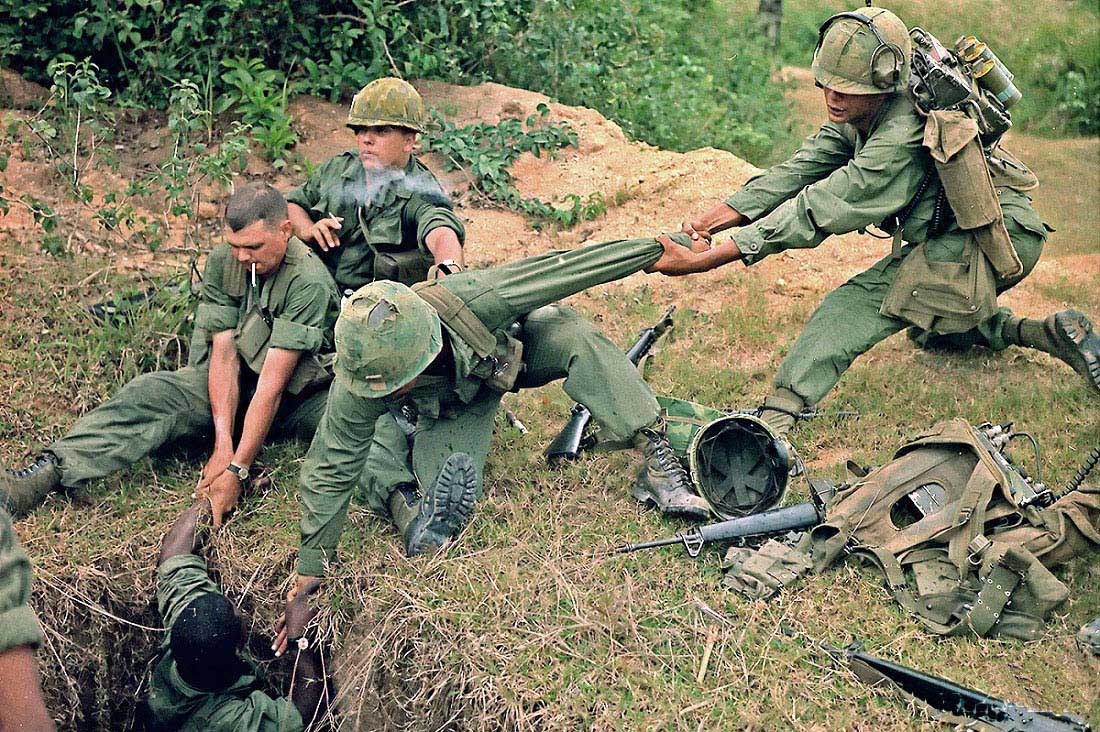
Nor was it easy to destroy the VC "subway." United States forces declared Cu Chi a free fire zone and dropped nearly 50,000 tons of bombs on the region, but the tunnels continued to operate. Blowing gas or pumping water into the tunnels also proved ineffective, as each section of an important tunnel could be sealed off by the Vietcong. The United States formed squads of "tunnel rats"— slim, small bodied men who probed tunnels (above)—and sniffer dogs were also used,
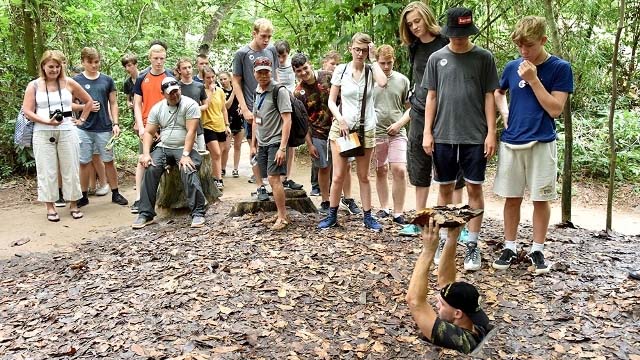 The current Cu Chi Tunnels is very popular but also very commercial (dubbed "Cong World" by a visiting Western reporter).
The current Cu Chi Tunnels is very popular but also very commercial (dubbed "Cong World" by a visiting Western reporter).
Souvenir shops sell war-related paraphernalia — you can buy a genuine pair of rubber sandals in the style worn by soldiers on the Ho Chi Minh Trail. Attendants at the shops wear black pajamas and rubber sandals, just as the Vietcong did.
After crawling around in the tunnels, visitors may, at a nearby firing range, empty an AK47 or M16 rifle at targets (the noise can be deafening).
Day Trip to Cu Chi by Private Car
Depart Saigon after breakfast with enough time to allow for reaching Tay Ninh and the noon for the Cao Dai service. We then depart after for the Cu Chi Tunnels and are usually back in Saigon mid-afternoon. A trip only to Cu Chi will place you back in Saigon by about lunch (or we may organize a delicious picnic in Cu Chi, and may be in order if running late departing Saigon in the morning).
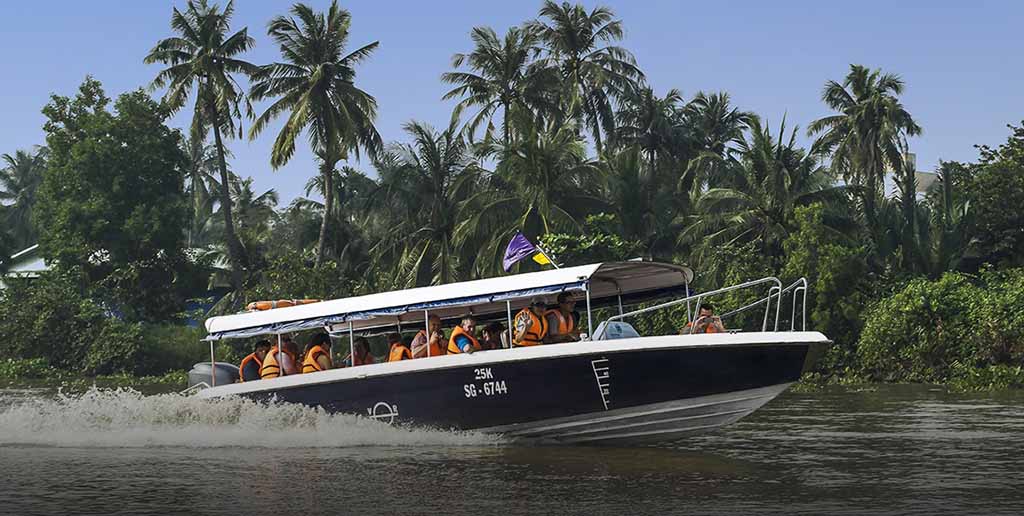
Cu Chi Tour by Speedboat Schedule (with private boat charter):
8:00 AM - Pick-up at hotel and transfer to the boat jetty in District 1
8:15 AM - Private boat departure to Cu Chi
09 :30 AM - Arrive in Cu Chi
11:30 AM - Finish touring. Lunch at a delightful and delicious local cafe
12:30 - 13:00 PM Depart by private car, arrival in Saigon and continued sightseeing in central Saigon.
